Mad Hedge Biotech and Healthcare Letter
January 16, 2025
Fiat Lux
Featured Trade:
(THE EYES HAVE IT)
(REGN), (SNY), (PFE), (BMY)
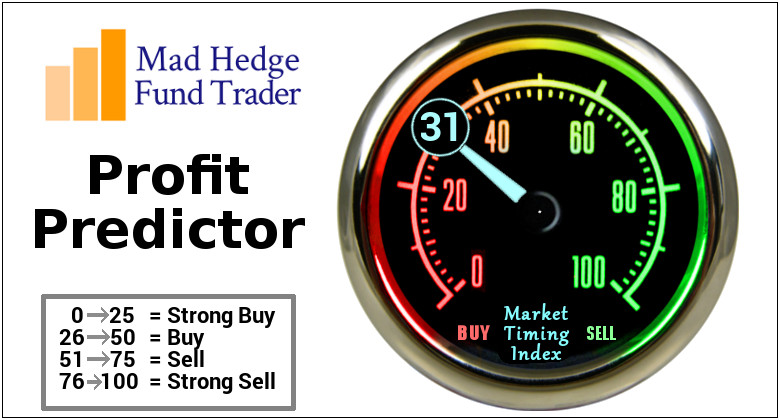
Mad Hedge Biotech and Healthcare Letter
January 16, 2025
Fiat Lux
Featured Trade:
(THE EYES HAVE IT)
(REGN), (SNY), (PFE), (BMY)

Last week, while waiting for my annual eye exam, I couldn't help but notice the parade of elderly patients shuffling in for their regular Eylea injections. My optometrist tells me these folks show up like clockwork every 4-8 weeks, rain or shine.
That's about to change, and therein lies a multibillion-dollar story.
You see, when Regeneron reported Q3 earnings on Halloween, boy, they sure had some treats for investors. Revenue hit $3.72 billion, up 11% YoY, with EPS coming in at a sweet $11.54.
But here's what really caught my attention: their cost of revenue was $1.762 billion, while R&D and SG&A expenses ran $1.271 billion and $714.4 million respectively.
Net income? A cool $1.34 billion. Not too shabby for a company whose main product is under siege from copycats.
Speaking of copycats, let's talk about Eylea. The original formula saw revenues drop 21% YoY to $1.145 billion – that's what happens when biosimilars crash your party.
This is where it gets interesting though: Eylea HD (think of it as Eylea's muscled-up big brother) jumped from a mere $43 million to $392 million YoY.
Sure, about $40 million of that came from wholesalers stocking up like it's Black Friday at Costco, but still – that's what I call a growth story.
I've been watching Regeneron since they were just a gleam in Wall Street's eye, and they've always had a knack for turning scientific breakthroughs into cold, hard cash.
Take Dupixent, their inflammation blockbuster co-developed with Sanofi (SNY). It just got FDA approval for COPD with an eosinophilic phenotype.
Why does this matter? Because we're talking about a $6 billion market opportunity here, folks.
About 36% of COPD patients have this particular flavor of the disease and trust me, there are more of them than you'd think still wheezing away on their old inhalers.
Want to know what else is cooking in their labs? They're working on antibodies that could make blood clots a thing of the past – think better than Eliquis, which pulls in $10 billion annually for Pfizer (PFE) and Bristol Myers Squibb (BMY). Their secret? Something called Factor XI, which could be a game-changer for the 1 in 5 patients at high risk for bleeding.
And because no self-respecting biotech can resist the siren call of the obesity market, they're also cooking up their own weight loss cocktail. Results won't drop until late 2025, but if they crack the code on keeping weight off AFTER stopping treatment, they'll have something Wegovy and Zepbound can't match.
The financials are rock solid, too: $2.012 billion in cash, $7.785 billion in marketable securities, and current assets of $19.334 billion versus current liabilities of just $3.661 billion.
They've generated $3.158 billion from operations in the first nine months of 2024 alone.
Yes, there's $1.984 billion in long-term debt, but with cash flow like that, it's about as worrying as a paper cut.
I've already started nibbling at Regeneron, and I'm looking to add more if it dips further. After all, this is a company that's proven it can grow revenues at upper single digits year over year while maintaining 25% free cash flow margins - the kind of numbers that make a value investor's heart skip a beat.
Sure, there are risks lurking around every corner – biosimilars nipping at Eylea's heels, Medicare negotiations that could squeeze margins, and clinical trials that might go sideways.
But with multiple growth catalysts and a pipeline that reads like a wish list for modern medicine, Regeneron's got more upside than my daughter's college tuition bills.
As my optometrist likes to say - in the land of the blind, the one-eyed man is king. But in the land of biotech, Regeneron's got a 20/20 vision for what's coming next.
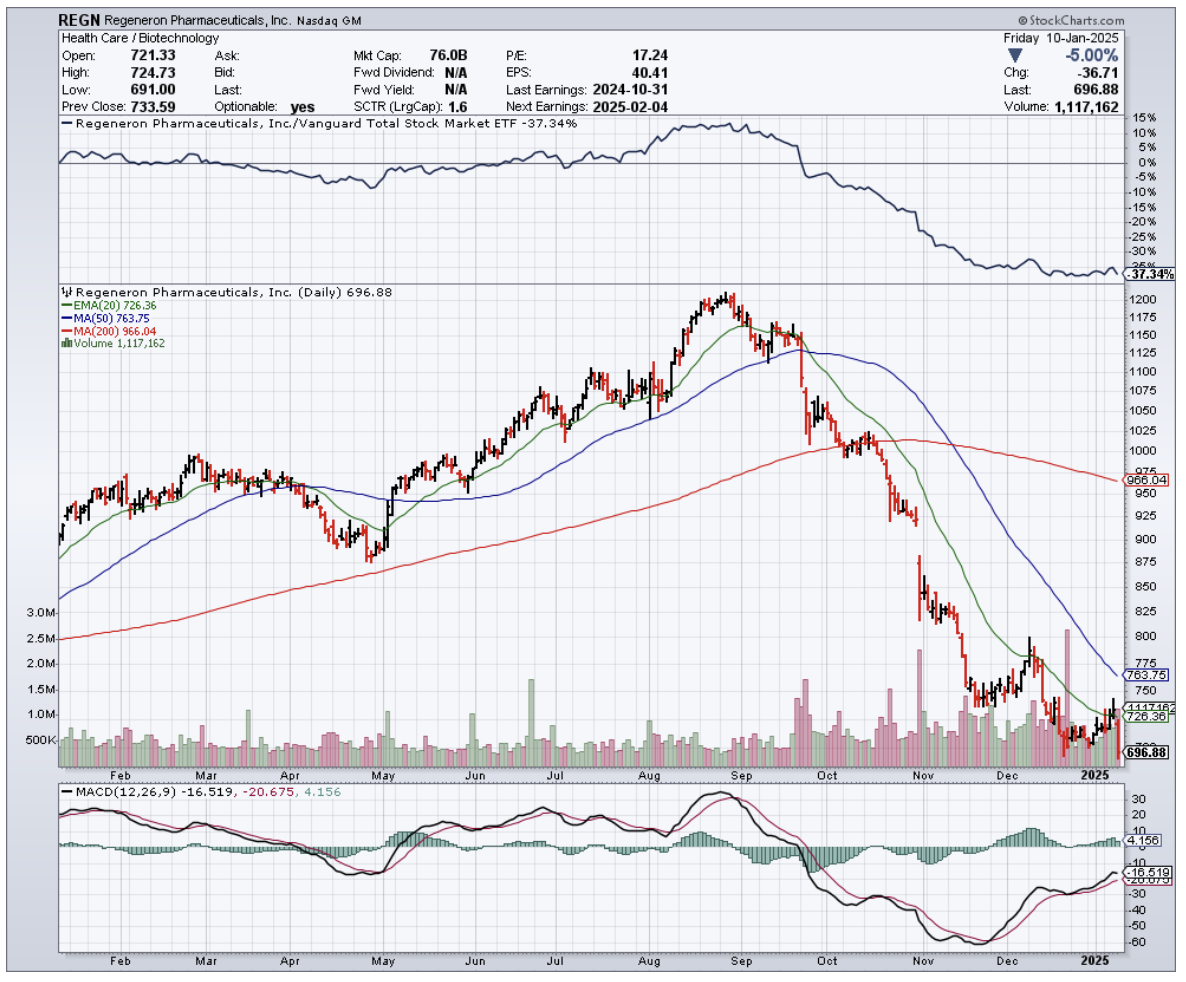
Mad Hedge Biotech and Healthcare Letter
January 14, 2025
Fiat Lux
Featured Trade:
(THE HEAVIEST HITTERS)
(NVO), (LLY)
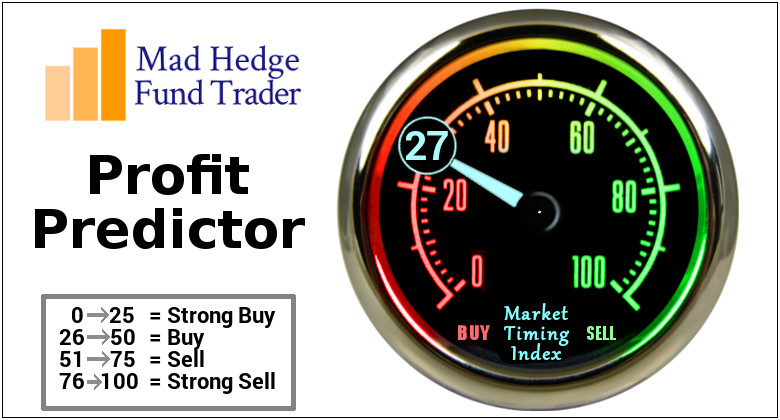
During my morning coffee run yesterday, I couldn't help but notice the transformation of my local café's menu. Where once stood a simple array of pastries, now sits a fortress of "keto-friendly" and "low-carb" options.
The barista told me they could barely keep them in stock. Times are changing, but not fast enough to stem the tide of what's become a global health crisis.
Here's a sobering statistic that explains why two pharmaceutical giants are about to have their best decades ever: In 1975, only 3 out of 100 men were obese. By 2022, that number exploded to 14. Women haven't fared much better, jumping from 6.6 to 18.5 out of 100.
But here's the real kicker – childhood obesity has multiplied TENFOLD since 1975.
Enter Novo Nordisk (NVO) and Eli Lilly (LLY), two companies that have discovered what might be the holy grail of modern medicine: drugs that can shrink waistlines almost as effectively as a year of dedicated dieting, but with considerably less willpower required.
I've been tracking both companies closely, and the numbers are staggering. Eli Lilly's tirzepatide (marketed as Mounjaro for diabetes and Zepbound for weight loss) has achieved what most thought impossible – a 20.80% average weight loss over 72 weeks. That's the kind of number that makes both bathroom scales and Wall Street analysts take notice.
Morgan Stanley certainly has. They're projecting the market for these weight-loss wonder drugs to explode from $6 billion in 2023 to an eye-popping $105 billion by 2030. And here's why I think even that might be conservative.
Last week, I caught up with an old friend who heads one of the largest healthcare investment funds in Boston. He shared an interesting insight: "The biggest problem these companies have isn't competition – it's keeping up with demand." Both Novo Nordisk and Eli Lilly are investing billions just to scale up production. It's like trying to drink from a firehose of opportunity.
Let's break down why these stocks are so compelling:
The market for diabetes medications is exploding. We're looking at 537 million adults with diabetes today, growing to 783 million by 2045. These aren't speculative numbers – they're based on current trends that show no signs of reversing.
Novo Nordisk currently dominates the GLP-1 market with a 66.80% share internationally, while Eli Lilly's tirzepatide holds 17.60%.
In the insulin market, Novo Nordisk's supremacy is even more pronounced, controlling 44.50% of the global market share compared to Eli Lilly's estimated 20-25%.
This is where it gets pretty interesting. Despite Novo Nordisk's market dominance, Wall Street has developed a crush on Eli Lilly.
Looking at the Price/CFO ratio, Novo Nordisk is trading BELOW its 10-year average, while Eli Lilly's valuation has soared to levels that would make a tech startup blush.
For 2025, Novo Nordisk's EPS is expected to hit $3.88. With a reasonable PE ratio of 25x, that suggests a fair value of $97.20 by the end of 2025 – an 11% upside potential.
Meanwhile, Eli Lilly, with an expected EPS of $21.57 and a justified PE ratio of 30x, points to a fair value of $647.10, suggesting it might be overvalued by about 17%.
The biggest risk? A global shift toward healthier lifestyles. But having just driven past my local McDonald's with a line wrapped around the building at 10 PM, I'm not losing sleep over that scenario.
My call? I'm long Novo Nordisk. While both companies are excellent, I prefer buying the market leader at a discount rather than the challenger at a premium. It's like buying beachfront property in Miami – the price might seem high today, but just wait until next year.
So, I'm maintaining a core position in Novo Nordisk with plans to add on any significant dips. The obesity epidemic isn't going away anytime soon, and neither is the demand for these medications.
For those looking to play both sides of this market transformation, a smaller position in Eli Lilly isn't crazy – just be prepared for some volatility given the current valuation.
And, yes, I'm aware there’s plenty of hand-wringing over these stocks' valuations. But the next time someone tells you the market's getting too heavy, just remember - in this case, that's exactly the point.
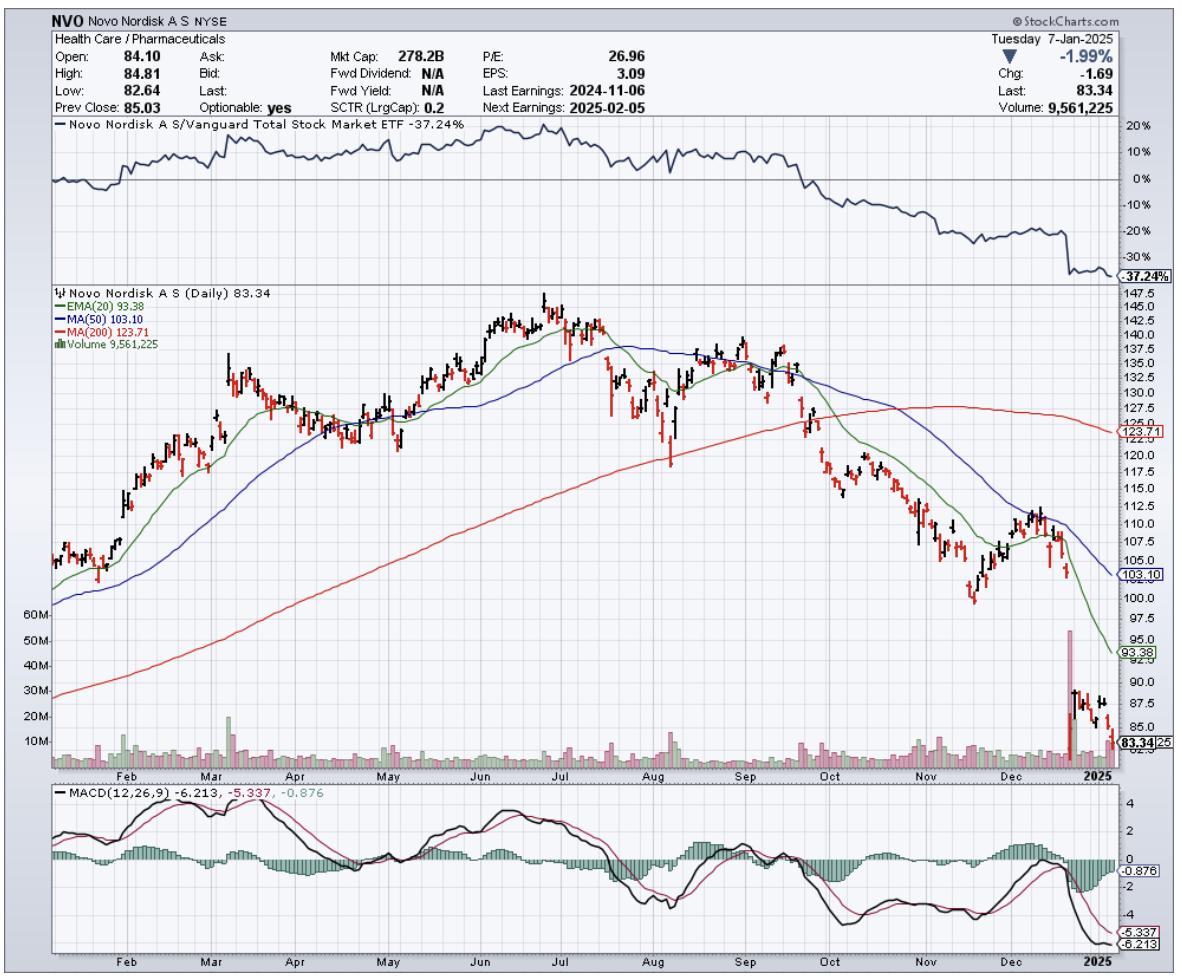
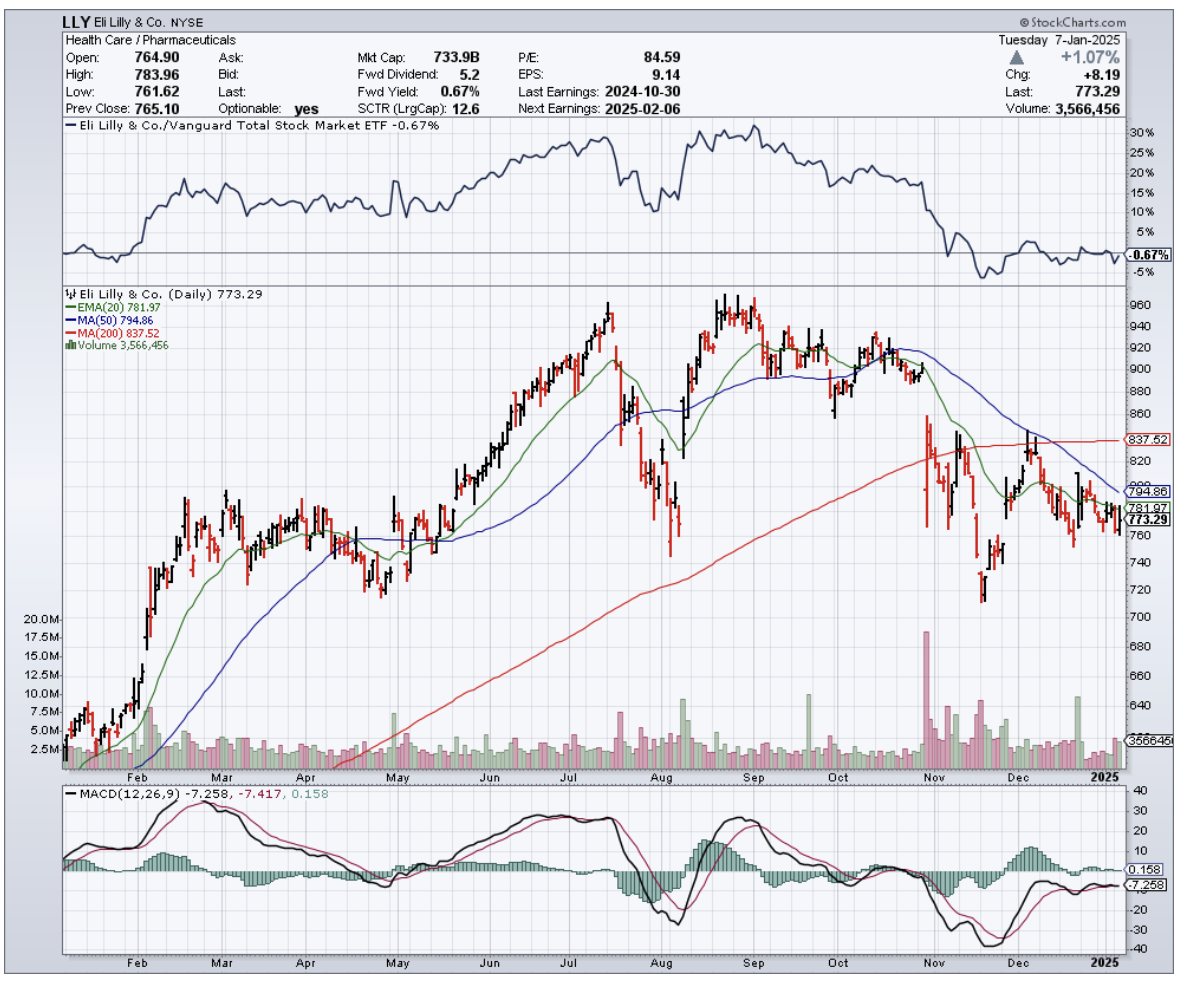
Mad Hedge Biotech and Healthcare Letter
January 7, 2025
Fiat Lux
Featured Trade:
(CELLS OF THE CENTURY)
(LCTX), (ATHX)
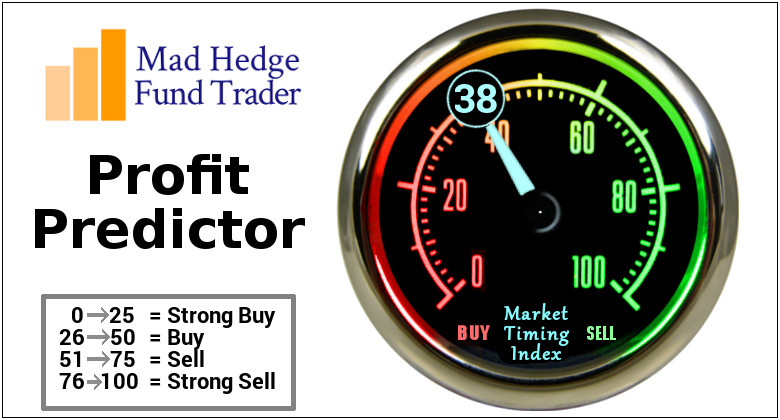
If you'd told me a decade ago that I'd be writing about hundred-year-olds' blood cells holding the secret to eternal youth, I would've thought you'd been reading too much science fiction.
Yet here I am, staring at data from a revolutionary new stem cell bank that's making immortality hunters drool and investors' wallets itch.
But let’s ground this exciting idea in the real world for a moment.
Let me back up a bit. Last week, while having dinner with a biotech analyst friend – let's call her Sarah – she couldn't stop talking about a groundbreaking new collection of stem cells derived from centenarians.
These remarkable individuals have done more than just reach triple digits – they've managed to dodge the usual buffet of age-related diseases that claim most of us long before we hit 100. But what makes this discovery particularly intriguing for us is how it bridges cutting-edge science with immediate market potential.
"These people aren't just old," Sarah explained, jabbing her fork at me for emphasis, "they're biologically younger than their birth certificates suggest." The data backs her up – these super-agers are clocking in at an average of 6.55 years younger than their chronological age. It's like finding a 1960 Corvette with the engine of a 2017 model.
And this biological time warp isn't just a scientific curiosity – it's becoming a goldmine for biotechnology companies looking to unlock the secrets of healthy aging.
Scientists can now take these centenarians' blood cells and reprogram them into induced pluripotent stem cells (iPSCs), creating a renewable source of cellular youth. Think of it as cellular time travel – these cells can become virtually any type of cell in the body, from heart muscle to brain neurons.
This versatility is precisely why the global stem cell therapy market has swelled to $11.8 billion and is projected to reach $31 billion by 2032.
Still, the field isn't without its volatility – funding swings from $1.2 billion in late 2022 to $233 million in early 2023 show just how quickly investor sentiment can shift in this space.
The investment landscape here is particularly fascinating because it spans both established players and innovative upstarts. Lineage Cell Therapeutics (LCTX) is targeting neurodegenerative diseases with cell-based therapies, while Athersys (ATHXQ) pushes forward with its MultiStem technology.
These companies are betting big on cellular solutions to age-related diseases, though we should watch trial results as carefully as they monitor their retirement accounts.
What sets these centenarian-derived cells apart is their unique genetic profile. Their immune cells show shifts and genetic variants that seem to protect against diseases that usually send most of us to the great beyond decades earlier.
Some male centenarians even show mosaic loss of the Y chromosome – a genetic quirk that might contribute to their longevity. This isn't just fascinating biology. It's practically a roadmap for developing new therapeutics.
The real game-changer is how these cells can serve as "disease-in-a-dish" models. Want to study Alzheimer's? Transform these cells into neurons. Curious about heart disease? Make some cardiac cells.
This capability is revolutionizing drug development, allowing companies to test new treatments more efficiently and potentially reduce the astronomical costs of bringing new drugs to market.
For those eyeing this space, the demographic trends are compelling. The world's population isn't getting any younger, and healthcare systems are groaning under the weight of age-related diseases.
That means companies that can leverage these iPSC lines for drug screening or biomarker development might strike it rich before anyone finds the fountain of youth.
The open-source nature of this iPSC resource is accelerating progress across the entire field. Like the early days of Linux, it's not about one company holding all the cards, but rather a collaborative rush toward breakthroughs.
This shared knowledge base is already helping researchers validate findings and refine therapeutic strategies, potentially shortening the timeline from discovery to approved treatment.
Looking ahead, we're set to watch as cellular biology and big data converge in ways we never imagined. So, the question now isn't if this field will transform medicine, but when – and more importantly for us, who will lead the charge.
Just remember, in biotech as in life, patience isn't just a virtue – it's a necessity. These breakthroughs move at their own pace, usually somewhere between "glacial" and "watched pot never boils." But when they hit? Well, that's when fortunes are made and medical textbooks are rewritten.
Now, if you'll excuse me, I need to check on my portfolio of longevity stocks. After all, I'm planning to live long enough to see how this all plays out – and maybe even long enough to benefit from these breakthrough treatments myself.
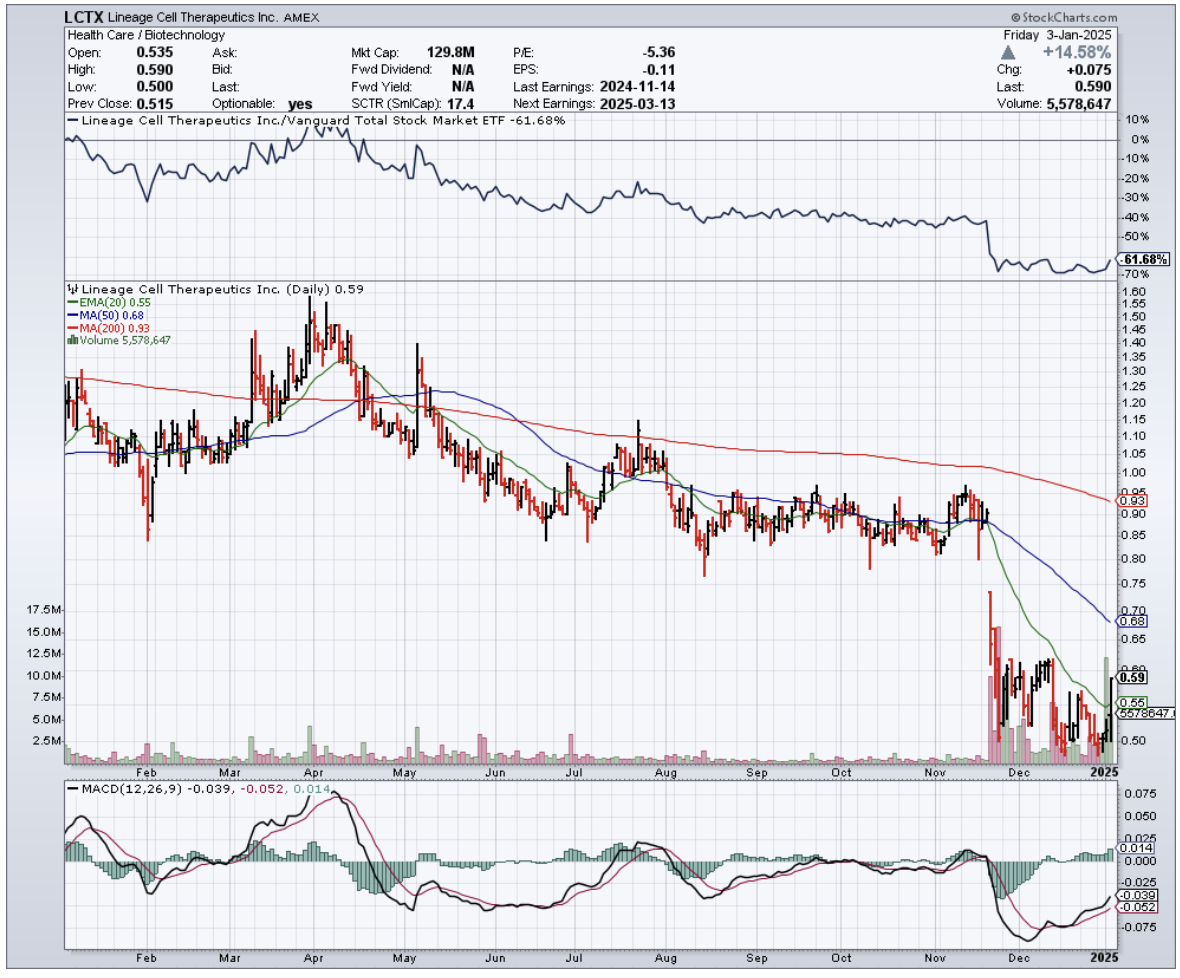
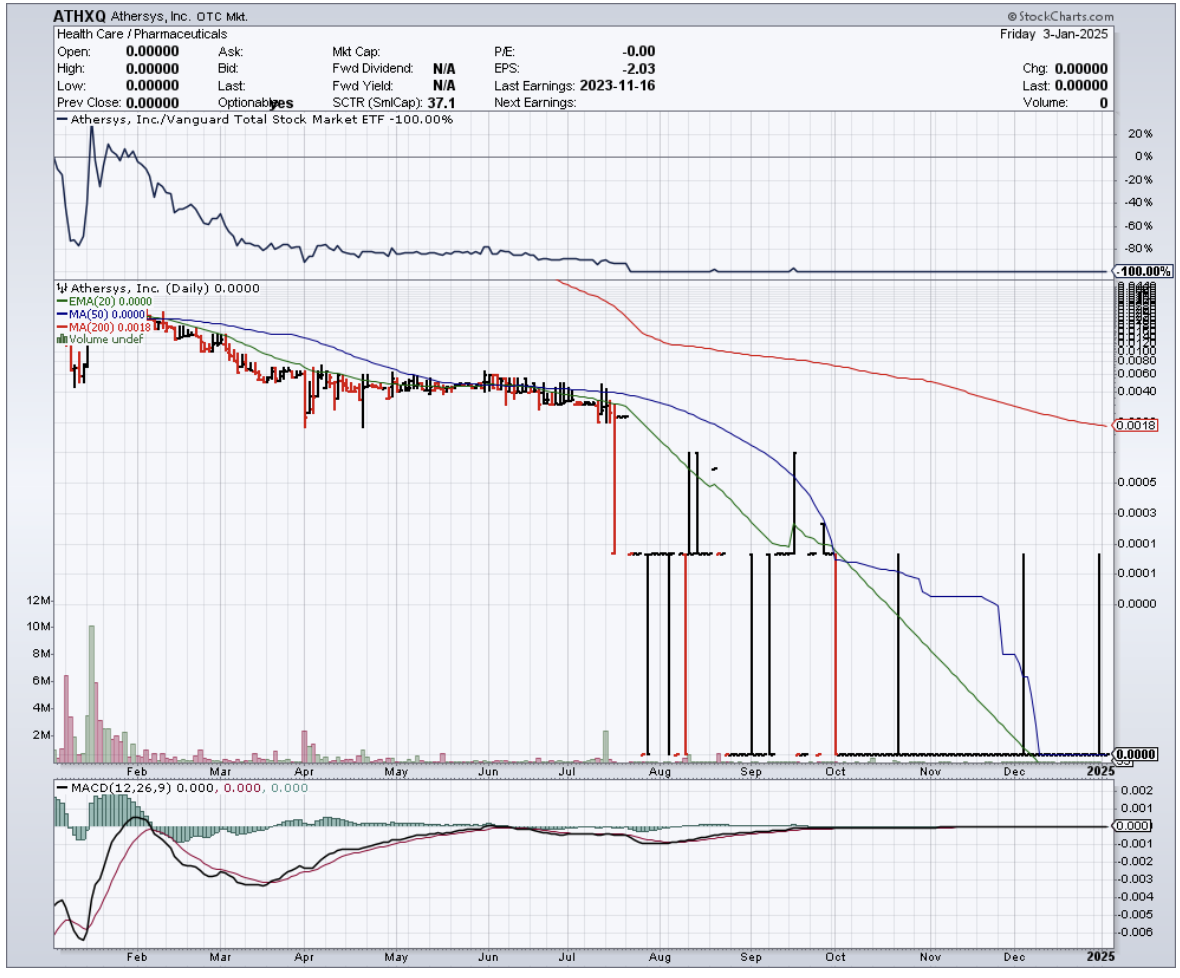
Mad Hedge Biotech and Healthcare Letter
January 2, 2025
Fiat Lux
Featured Trade:
(YOUR NEXT MIRACLE DRUG WAS WRITTEN IN PYTHON)
(IQV), (EXAI), (CRL), (ICLR), (PRXL)

I had an interesting conversation with my daughter last week during one of her rare appearances from her computer science lab. She was telling me about her latest project - using artificial intelligence to predict protein folding, something that used to take months and now happens in hours.
"Dad," she said, looking up from a bowl of ramen that probably cost me 50 cents, "this is going to change everything about how we make medicine."
She's right, and it got me thinking about the transformation happening in clinical trials - a market currently valued at $57.76 billion that's expected to more than double by 2032.
We're looking at a 7.1% compound annual growth rate, but these numbers only tell part of the story.
I spent some time digging through the data and talking to folks at companies like IQVIA (IQV), where they're using AI to match patients to trials 40% faster than traditional methods.
Think about that for a second - we’re looking at a process that used to take months now happening in weeks, while managing to maintain the kind of accuracy that makes FDA regulators sleep well at night.
Speaking of the FDA, they're cooking up new diversity action plans that aim to make clinical trials look more like actual America. It's definitely the right thing to do, but like most regulatory shifts, it's moving at the speed of government bureaucracy.
This is keeping Contract Research Organizations (CROs) on their toes, though the smart ones are already adapting.
Take Exscientia (EXAI), for example. They're not just using artificial intelligence - they are letting this technology design drug candidates that are already in clinical trials. It's like having a thousand researchers working 24/7 without coffee or bathroom breaks.
But before you rush to buy companies in this sector, it pays to remember that not everyone in this space is thriving.
Charles River Laboratories (CRL) and Icon (ICLR) have been dealing with declining revenues faster than a tech startup burning through venture capital.
The global biotechnology market itself tells an interesting story. Currently valued at $1.55 trillion, it's expected to grow at nearly 14% annually through 2030.
Meanwhile, AI is estimated to generate up to $110 billion in annual economic value for the pharmaceutical industry. That's not pocket change, even by Silicon Valley standards.
Last weekend, while refinishing an antique desk I picked up at an estate sale (turns out it's worth more than my first car), I got a call from a biotech analyst friend. He was worried about the shift in clinical trial geography.
Europe's share of global trials has dropped from 22% to 12% over the past decade, while Asia-Pacific is becoming the new hotspot.
Companies like Parexel (PRXL) and Headlands Research are capitalizing on this trend, particularly in China and India, where regulatory frameworks are streamlining faster than a Formula 1 pit crew.
The traditional factors that used to drive this industry - pure research horsepower and deep pockets - are being replaced by computational efficiency and AI-driven insights.
It's similar to what happened in the financial markets when algorithmic trading took over from floor traders. The winners will be those who adapt fastest to this new reality.
Looking ahead to 2025 and beyond, I'm watching two potential party crashers: a return of regulatory uncertainty and the ever-present possibility of a new pandemic.
But barring these black swan events, we're looking at a sector that's transforming faster than my daughter's college curriculum.
Speaking of which, she just texted me about her latest assignment - using machine learning to optimize clinical trial protocols. Maybe I should start asking her for stock picks.

Mad Hedge Biotech and Healthcare Letter
December 31, 2024
Fiat Lux
Featured Trade:
(SOMETIMES WALL STREET GETS IT WRONG)
(BMY), (AAPL), (MRK)

Sitting in my stateroom aboard the Coral Princess, about 200 miles off Mexico's west coast, I found myself chuckling at the market's reaction to Bristol-Myers Squibb’s (BMY) latest developments. Sometimes Wall Street reminds me of my old physics professor - brilliant but occasionally missing the forest for the quantum trees.
Here's what caught my attention: BMY's stock has outperformed the broader market by +15% since July, yet still trades at a measly 7.91x forward P/E while its sector peers strut around at 20.53x. It's like finding a Ferrari in a used car lot, priced like a Corolla.
The cynics, of course, point to the patent cliff. "What about Eliquis in 2026? Opdivo in 2028?" they ask, wringing their hands. But that's exactly where it gets interesting.
Just earlier this month, BMY announced FDA approval for Opdivo Qvantig - their new subcutaneous version that cuts treatment time from 30 minutes to 5 minutes. If you've ever spent time in cancer treatment centers like I have, you know those 25 minutes make a world of difference.
BMY's commercial team expects this version to capture 75% of Opdivo's business, with 30-40% of patients switching from IV. That's not just convenience - it's strategic patent life extension.
Speaking of strategy, let's talk about their growth portfolio, which has quietly expanded 20% year-over-year and now represents 48.7% of their business.
Remember when Apple (AAPL) transformed from computers to mobile devices? BMY is pulling a similar pivot, just without the flashy keynotes.
Take their $14 billion Karuna acquisition. Their newly approved schizophrenia treatment, Cobenfy, targets a market projected to hit $15.23 billion by 2034. The timing here is masterful - monetization starts in early 2025, well before the patent cliffs hit.
Meanwhile, they're cleaning up their balance sheet faster than a neat freak with a new vacuum. They've already slashed $4.31 billion in debt this year, with plans to cut $10 billion by 2026.
Their free cash flow has grown to $13.8B, up 18.1% sequentially. At this rate, they'll have plenty of dry powder for more strategic moves.
But here's what really makes me scratch my head: while everyone's fixated on the patent cliff, BMY has quietly added 8 new oncology registrational trials in the past year. Their oncology trio - Opdivo, Yervoy, and Opdualag - is growing at 7.6% year-over-year.
Sure, Merck's (MRK) Keytruda is the 800-pound gorilla with $25 billion in sales, but BMY's playing a different game - diversification with shots on goal across multiple therapeutic areas.
Now, I'm not suggesting you back up the truck tomorrow morning. The stock might see some pressure after the January 3, 2025 ex-dividend date, possibly testing support at $51 or even $48. But with a 4.45% dividend yield and a valuation at half its historical average, patient investors might find this an interesting entry point.
Speaking of timing - Wall Street's greatest fortunes were made by investors who saw value where others saw problems. Right now, most analysts are staring at BMY's patent cliff like deer in headlights.
Meanwhile, I'm seeing a company with a 4.45% dividend yield, a growth portfolio expanding at 20% annually, and a valuation that's practically begging to double.
As I wrap this up from somewhere off the Mexican coast (where I'm supposedly on vacation but can't help analyzing stocks between rounds of Monopoly), I'm reminded of something I learned in my decades of trading: The crowd is usually looking through the wrong end of the telescope.
While they're zoomed in on 2026's patent expirations, they're missing the transformation happening right now in front of their eyes.
Maybe that's why I've averaged +50% returns for over a decade - I tend to look where others don't. BMY just might be one of those opportunities that makes next year's Christmas gift to my subscribers an even bigger winner than this year's +75.25% return.
Now, if you'll excuse me, my banjo needs tuning, and I have a Monopoly empire to build. But remember - in both board games and markets, the best players are always thinking three moves ahead. BMY's management certainly is.
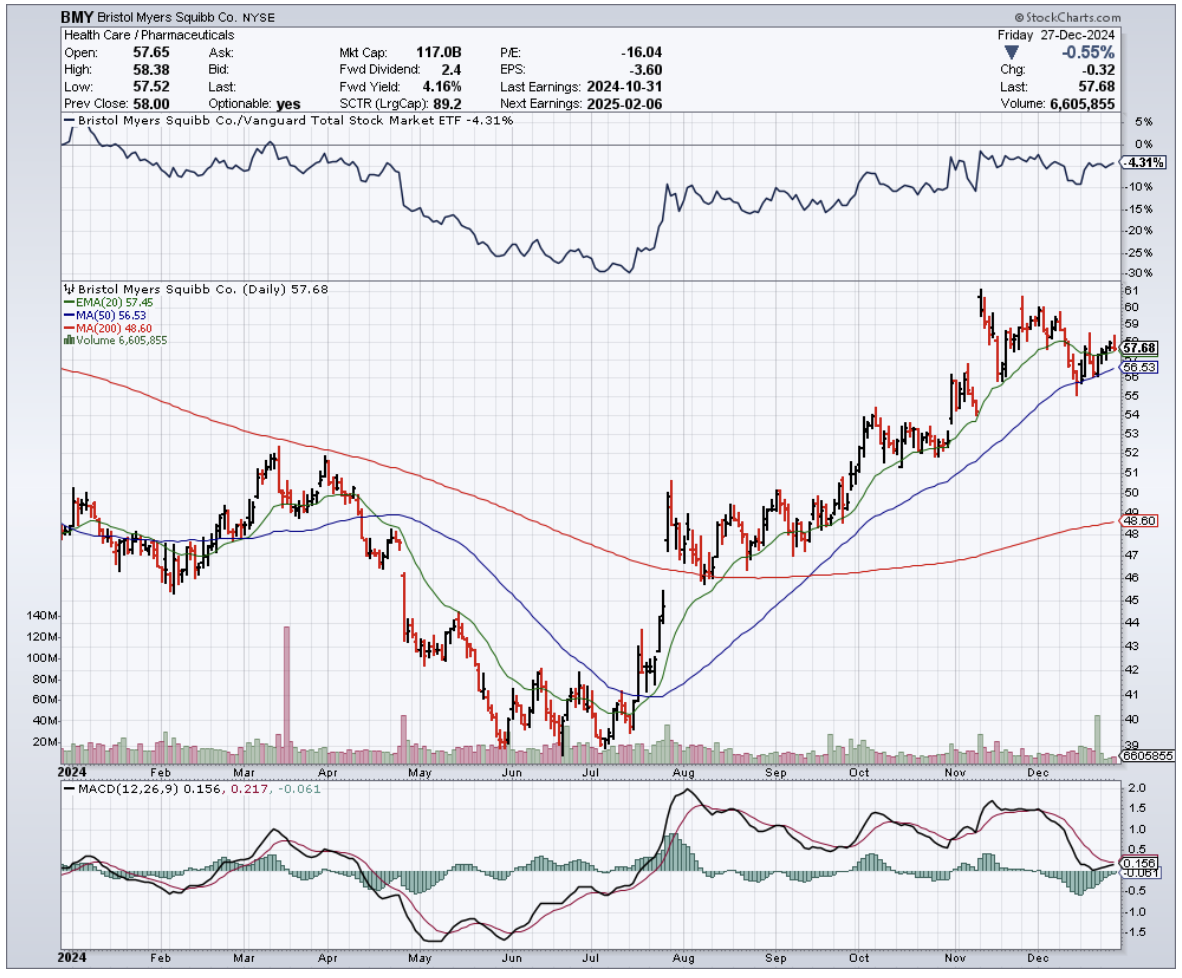
Legal Disclaimer
There is a very high degree of risk involved in trading. Past results are not indicative of future returns. MadHedgeFundTrader.com and all individuals affiliated with this site assume no responsibilities for your trading and investment results. The indicators, strategies, columns, articles and all other features are for educational purposes only and should not be construed as investment advice. Information for futures trading observations are obtained from sources believed to be reliable, but we do not warrant its completeness or accuracy, or warrant any results from the use of the information. Your use of the trading observations is entirely at your own risk and it is your sole responsibility to evaluate the accuracy, completeness and usefulness of the information. You must assess the risk of any trade with your broker and make your own independent decisions regarding any securities mentioned herein. Affiliates of MadHedgeFundTrader.com may have a position or effect transactions in the securities described herein (or options thereon) and/or otherwise employ trading strategies that may be consistent or inconsistent with the provided strategies.
This site uses cookies. By continuing to browse the site, you are agreeing to our use of cookies.
OKLearn moreWe may request cookies to be set on your device. We use cookies to let us know when you visit our websites, how you interact with us, to enrich your user experience, and to customize your relationship with our website.
Click on the different category headings to find out more. You can also change some of your preferences. Note that blocking some types of cookies may impact your experience on our websites and the services we are able to offer.
These cookies are strictly necessary to provide you with services available through our website and to use some of its features.
Because these cookies are strictly necessary to deliver the website, refuseing them will have impact how our site functions. You always can block or delete cookies by changing your browser settings and force blocking all cookies on this website. But this will always prompt you to accept/refuse cookies when revisiting our site.
We fully respect if you want to refuse cookies but to avoid asking you again and again kindly allow us to store a cookie for that. You are free to opt out any time or opt in for other cookies to get a better experience. If you refuse cookies we will remove all set cookies in our domain.
We provide you with a list of stored cookies on your computer in our domain so you can check what we stored. Due to security reasons we are not able to show or modify cookies from other domains. You can check these in your browser security settings.
These cookies collect information that is used either in aggregate form to help us understand how our website is being used or how effective our marketing campaigns are, or to help us customize our website and application for you in order to enhance your experience.
If you do not want that we track your visist to our site you can disable tracking in your browser here:
We also use different external services like Google Webfonts, Google Maps, and external Video providers. Since these providers may collect personal data like your IP address we allow you to block them here. Please be aware that this might heavily reduce the functionality and appearance of our site. Changes will take effect once you reload the page.
Google Webfont Settings:
Google Map Settings:
Vimeo and Youtube video embeds:
